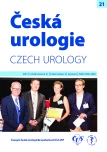Agranulocytosis after analgesic treatment for renal colic
Authors:
Gabriela Čečerle 1; Vladimír Šámal 1,2; Jan Mečl 1
Authors‘ workplace:
Urologické oddělení, Krajská nemocnice Liberec, a. s.
1; Urologická klinika Fakultní nemocnice a Lékařské fakulty UK, Hradec Králové
2
Published in:
Ces Urol 2017; 21(4): 310-313
Category:
Case report
Overview
Renal colic is a symptom characterized by cramp-like, recurrent flank pain, often accompanied by vomiting and other vegetative symptoms. Urologists encounter patients with renal colic almost daily and its diagnosis and treatment is one of the basic urological skills. We present a case of a 26-years-old patient who was examined with renal colic at our clinic. Renal CT scan showed the presence of 3mm stone in the juxtavesical part of the ureter on the left. The patient was instructed that the stone could pass spontaneously off the ureter and was sent home with analgesic drugs. The patient was hospitalized for recurrent pain after a few days. An agranulocytosis was found in the blood count on admission and further examinations it was found that the agranulocytosis was caused by medication. During the week there was a very slow increase of neutrophil count.
Key words:
Renal colic, agranulocytosis, analgesic therapy, metamizol.
Sources
1. Petřík A. Diagnostika a léčba urolitiázy. Urol. praxi 2011; 12(3): 173–179.
2. Türk C, Petřík A, Sarica K, et al. EAU Guidelines on Diagnosis and Conservative Management of Urolithiasis. Eur Urol. 2016 Mar; 69(3): 468–474. Available from https://www.ncbi.nlm.nih.gov/pubmed/26318710.
3. Holdgate A, Pollock T. Nonsteroidal anti‑inflammatory drugs (NSAIDs) versus opioids for acute renal colic. Cochrane Database Syst Rev. 2005; 18(2): CD004137.
4. Hess L. Pethidin slaví 70 let. Remedia 2009; 19: 213–214.
5. Ürge T, Běhounek P, Janda V, Eret V, Hora M. Renání kolika. Urol. praxi 2016; 17(5): 210–213.
6. SPC Novalgin®.
7. Zeiner E, Blaser LS, Tisljar K, Heim D, Taegtmeyer A. Praxis 2015; 104(3): 151–154.
8. Penka M, Tesařová E, Janků L, et al. Hematologie a transfuzní lékařství I. Grada Publishing, a. s. 2011; 208.
9. Lampl C, Likar R. Metamizol: Wirkmechanismen, Interactionem und Agranulozytoserisiko. Schmerz 2014; 28(6): 584.
10. Jasiecka A, Maślanka T, Jaroszewski JJ. Pharmacological characteristics of metamizole. Polish J Vet Scien 2014; 17(1): 207–214.
11. Fendrich Z. Metamizol – nové účinné analgetikum s dlouhou historií: přehled farmakologie a praktického využití. Čas Lek 2000; 440–444.
12. Stammsschulte T, Ludwig WD, Muhlbauer B, Bronder E, Gundert‑Remy U. Metamizole (dipyrone) – associated agranulocytosis. An analysis of German spontaneus reports 1990–2012. Eur J Clin Pharmacol. 2015 Sep; 71(9): 119–38.
13. Maj S, Lis Y. The incidence of metamizole sodium‑induced agranulocytosis in Poland. J Int Med Res. 2002; 30(5): 488–495.
Labels
Paediatric urologist Nephrology UrologyArticle was published in
Czech Urology

2017 Issue 4
Most read in this issue
- Experience with the prostate health index in daily clinical practice
- Agranulocytosis after analgesic treatment for renal colic
- Home‑based sperm analysis with a smartphone? Welcome to the age of telespermatology
- Flow cytometry analysis of sperm quality in sub‑fertile men
